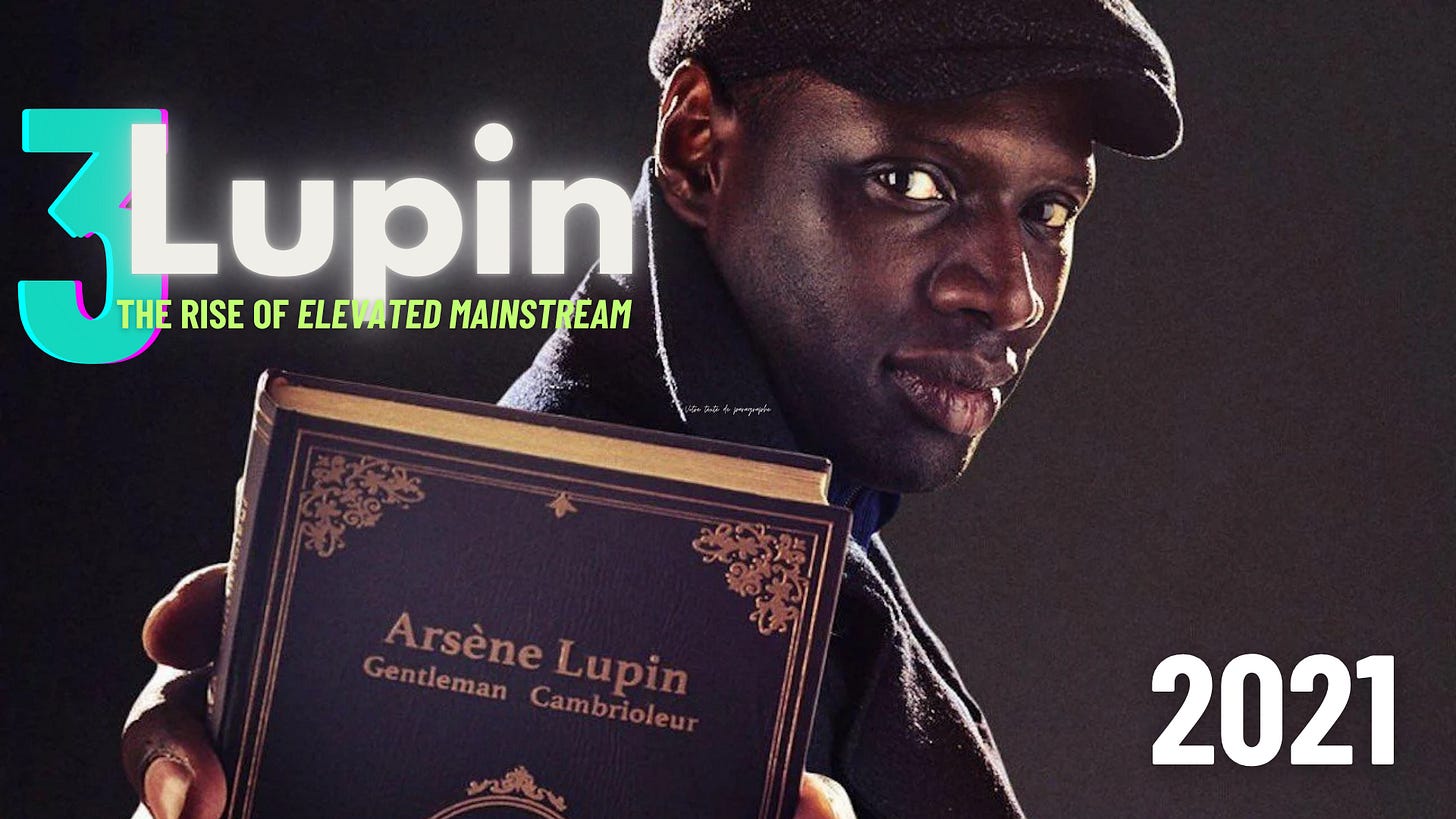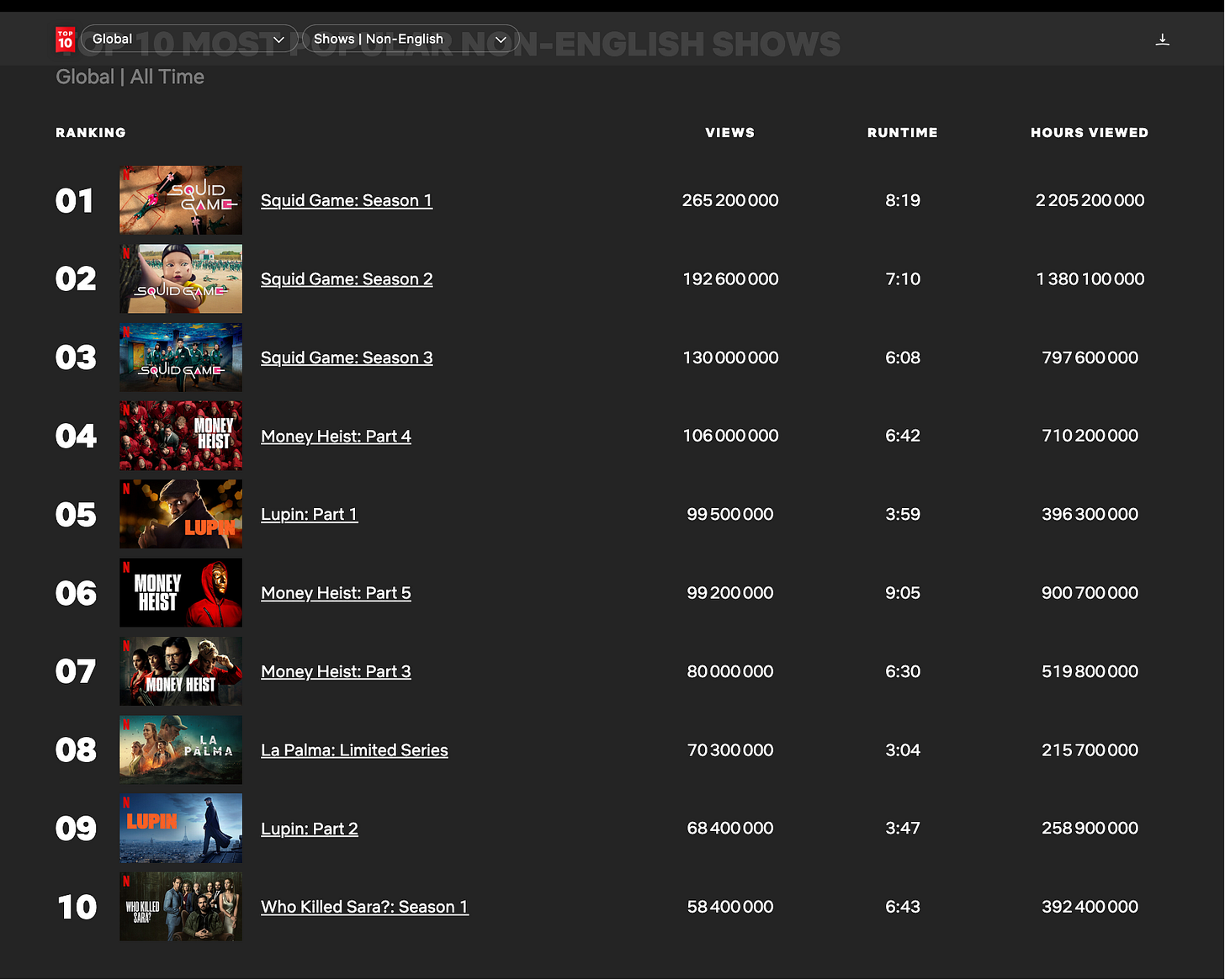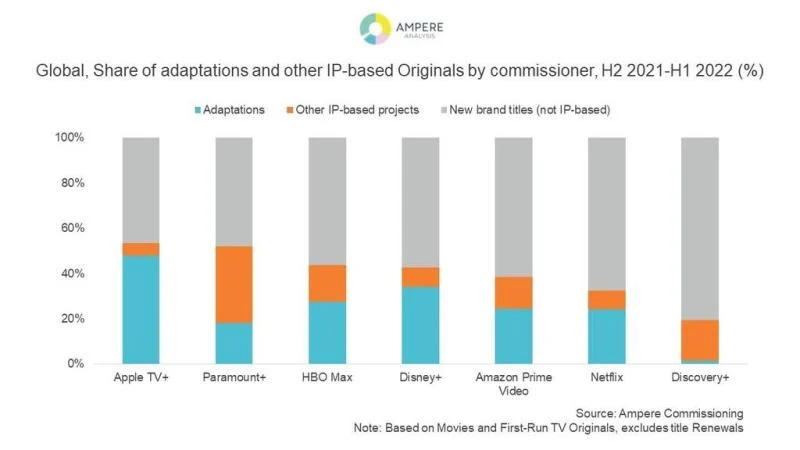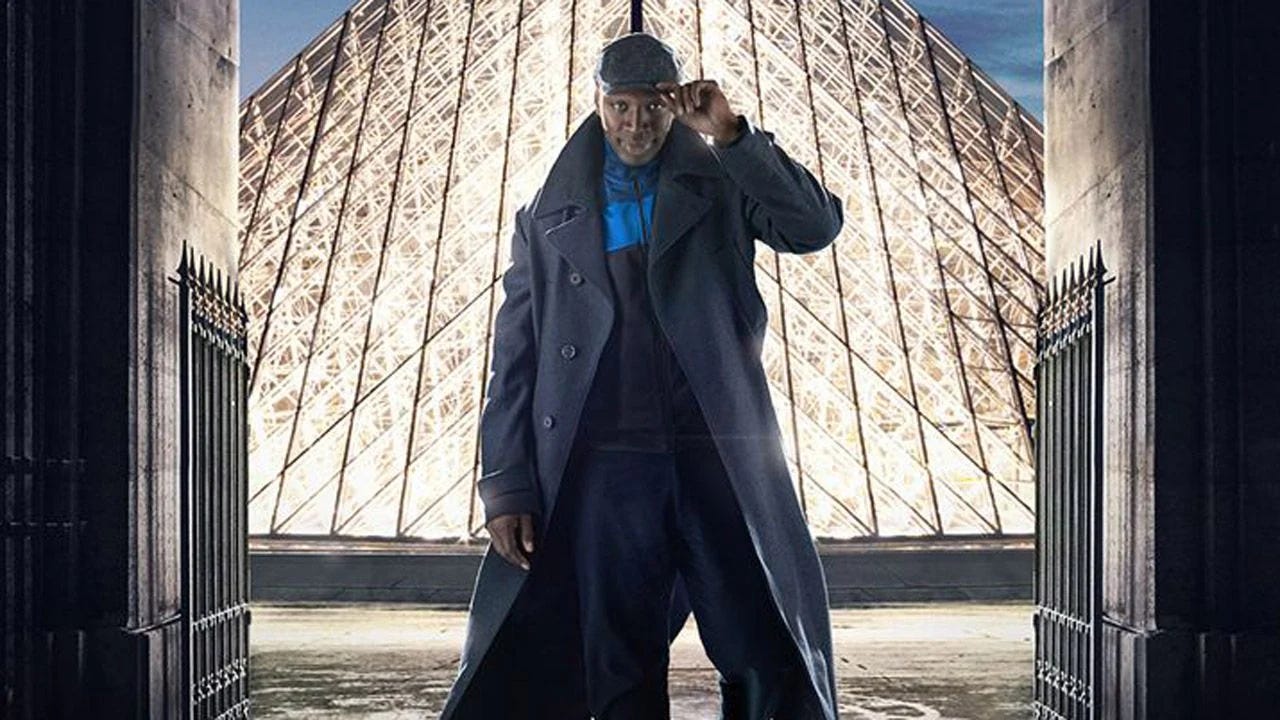📺 HOW STREAMING PLATFORMS TRANSFORMED SCRIPTED TELEVISION # 3
Here's the third episode of my summer series. Today, we're going to examine the new challenge facing platforms: how to become MAINSTREAM while remaining PREMIUM?
2021: LUPIN AND THE RISE OF “ELEVATED MAINSTREAM”
January 2021. The world is slowly emerging from months of lockdowns and curfews. The global entertainment industry is still reeling. While filming has resumed—haltingly—for the past six months, movie theaters remain shuttered. But there’s one major silver lining: viewership for both linear TV and streaming is soaring. In France, where I live, TF1 is about to unleash a national juggernaut with High Potential, racking up nearly 12 million viewers per episode.
On the streaming front, the mood is just as buoyant, with new players entering the arena at full speed. After Disney+ and Apple TV+ debuted in 2019, 2020 saw premium cable brand HBO and the rest of the WarnerBrosDiscovery family take their global shot under the banner HBO Max. By 2021, Paramount+ is christened, along with Star—an adult-content vertical within Disney+ designed to house programming from FX, Hulu, Fox, and ABC.
A WINDOW OF HYPER TV-CONSUMPTION
These launches land at the perfect time, with audiences subscribing en masse. Thanks—or due—to lockdowns and work from home, “non-essential” workers suddenly find themselves with ample time to stream films and series. And with most retail outlets, cultural venues, and outdoor entertainment still closed, household budgets shift toward premium TV subscriptions.
Industry professionals experience the moment as a kind of euphoric bubble, convinced that streaming is an endless Eldorado. Mega-deals are inked with A-list showrunners. New production companies spring up almost weekly, banking on a presumed wave of demand and fueled by “talent” now treated like the new black gold.
A FRENCH MEGA-HIT GOES GLOBAL
It’s in this booming context that Lupin drops on Netflix: January 8, 2021, the first five episodes of Season 1 go live. A Gaumont production, Lupin quickly climbs and stays in the platform’s global non-English top 10. To this day, Seasons 1 and 2 still rank among Netflix’s top-performing international titles, rivaling the numbers of Money Heist, another non-English-language mega-hit.
Lupin achieves unprecedented visibility for a French series. It becomes the first French Netflix original to scale such heights. A national burst of pride follows. Omar Sy graces the covers of major newspapers, becomes a household name internationally, and is invited to U.S. late-night royalty—Jimmy Fallon, Jimmy Kimmel. His career reaches a whole new level.
(Screenshot of the Tudum website, July 27th 2025)
OPERATION "RETAIN SUBSCRIBERS"
Lupin made its mark in many ways, but its release represents a turning point in how series are rolled out by streamers. While the practice of splitting season releases into sub-blocks of a few episodes is now commonplace, at the time, it represented a novelty compared to the binge-watching dogma. With COVID having slowed production, all broadcasters became conservative with their new content. Generally speaking, new entrants quickly realized they couldn't maintain the frenetic pace of original programming set by Netflix before the pandemic. Producing fewer new series, they were forced to spread out their releases to maintain subscriber excitement throughout the year and let buzz build. Some even advocated that the weekly rhythm was the only way for a series to make a lasting impact on audiences. With cancellation or churn now possible with just a few clicks, it became crucial to prevent members—as they're called at Netflix—from subscribing to watch a series and unsubscribing a week later.
ALL STARS ALIGNED
But where does Lupin's stratospheric success come from, and what does it signify? It's always easier to post-rationalize success, but here we can say that the stars were carefully aligned by Gaumont and Netflix above the series' cradle...
Factor #1: The IP
Maurice Leblanc's hero is famous in many countries around the world, thanks primarily to literature but also to manga. It's a transnational French myth. Less known than Sherlock Holmes of course, but famous enough to generate audience enthusiasm, particularly among adults. We are therefore dealing with intellectual property (IP), a solid "brand" that will both directly engage parts of the audience and reassure the broadcaster. This is the main benefit of IP: no need to get bogged down in meetings with complicated pitches. No need to explain the concept to the public either. IP is a Swiss Army knife. It's reportedly easier to sell at all stages > by the producer to the broadcaster > by programming executives to their bosses > and finally by the marketing department to viewers.
Having worked in cinema and television for a long time, IP now triumphs on platforms, where competition is such that it becomes very difficult for each new release to emerge. Note, however, that Netflix distinguishes itself each year in surveys by British company Ampere Analysis, with a lower rate of adaptations and therefore IP, than its competitors (less than 40%). A taste for original creation and boldness that also corresponds to a leadership position and a volume of orders superior to others.
(Source: Ampereanalysis.com)
The IP in question can certainly be a book, but also a well known character (Bardot), a video game (The Last of Us), a film (Fargo), a foreign series (In Treatment), a toy (Barbie), a monument (Notre Dame), the victim of a tragic news story (Detroit), a podcast (Dirty John), a newspaper article, or several things at once, these categories not being mutually exclusive. IP generates a virtuous circle, where the audiovisual work is driven by the notoriety of the brand that gave it birth, but where the original brand will itself benefit from the promotion offered by the audiovisual work, relaunching book sales, toy sales, or monument visits.
In this regard, Netflix France productions are often infused, like Lupin, with another IP that marketing professionals call an umbrella brand: France and Paris, quite simply. On February 1, 2024, Netflix and Atout France issued a joint press release, soberly titled "Netflix and Atout France join forces ho highlight France’s cultural and tourist appeal." It detailed, backed by surveys, how Netflix's French productions, led by Lupin obviously, make platform members want to discover our beautiful country. An ultimate illustration of the virtuous circle: the France IP makes people want to watch Netflix's French programs, which in return make people want to discover France.
(Omar Sy as Lupin in front of the Louvre pyramid, key visual from season 1)
IP is all the more important for a broadcaster when the investment they're about to make is high, therefore risky. Lupin certainly fits into a sub-genre that has already proven itself on Netflix with Money Heist, that of heists & big-hearted thieves. But unlike its Spanish big sister, which had been conceived initially for Antenna 3 in a relatively low-cost approach with its recurring sets and long melodrama sequences, Lupin fully exploits the codes of its sub-genre's parent category: adventure. Adventure is immediately very expensive, because "adventure" means chases, stunts, spectacular sets... Usually, French streamer productions have an average budget three times higher than that of free to air channels, and for Lupin, some mention even more. An absolutely standard amount seen from Los Angeles, but exceptional for French series.
Factor #2: The Package
The word may seem brutal when applied to a work of art, but it's now on everyone's lips, among producers and broadcasters. Packaging consists of associating a series, from the conception stage and even before its presentation to the broadcaster, with top-tier talent. By talent I mean, besides creators, people (talented we hope) who also have strong public recognition. While some legacy channels here are wary of packaging, to ensure they'll be able to participate in creative choices like casting and maintain control of the work, on platforms, packages are developing at breakneck speed. Some don't even hide from producers that without a package proposed from the start, it will be difficult to sell them anything.
Packaging can be practiced with TV stars, singers, stand-up comedians, or social media personalities, but what platforms prize most are movie stars, especially if they've never done series. They'll bring a high-end patina, aimed at provoking validation of value for money, like "we were right to pay for our subscription." Movie stars are rare on the small screen, or rather they're rare on free to air channels, where only a handful have ventured. Indeed, why take the risk of offering yourself free to an audience accustomed to paying to see you? Whereas a subscription channel or platform is completely different... It's almost as chic as cinema, it doesn't damage the brand.
Lupin displays a cast with 3 movie stars, likely to attract different generations, at least among French viewers: Omar Sy, Ludivine Sagnier, and Nicole Garcia. In 2021, in France, Omar Sy was already a huge star of cinema, TV, and stand-up. He was also beginning to be recognized abroad thanks to The Intouchables (2011), a French film that exported well, and appearances in the X-Men or Jurassic World franchises. Finally, an additional layer of packaging and reassurance was added with the participation of Louis Leterrier, a director known to blockbuster fans (The Transporter, Now You See Me...), for the first 3 episodes of season 1.
The only small disappointment ammong the Gallic screenwriting community: Lupin's creation is credited at the opening to George Kay, an English writer who had just collaborated with Netflix on the multi-country series Criminal. Although several French screenwriters participated in Lupin's development before his arrival, he ultimately led the writing, with more discreet collaboration from Frenchman François Uzan. It wasn't until several years later, in 2024, after George Kay's departure for other adventures, that episodes were fully entrusted to French screenwriters, including Tigran Rosine and Florent Meyer, from the original pre-George Kay team.
Factor #3: Elevated Mainstream
Elevated mainstream, Elevated broadcast, or Premium light—the term appeared in the American trade press around 2020 to qualify the evolution of streaming production. Until then, even though they didn't forbid themselves from producing very mainstream works, streamers preferred to buy them ready-made from studios (Grey's Anatomy, The Office, Friends, Suits...) and focus their original production on auteur policies, with singular voices. The idea was, as I wrote previously, to mark their territory by winning statuettes and trigger passionate fandom among targeted audience categories. Just like premium pay TV before them (HBO, Showtime, Starz…), streamers tended to favor subjects ill-suited to family viewing, traditionally prized by free to air broadcasters, more consensual in their offerings.
Sunny, positive, all-audience, Lupin is mainstream or broadcast. In this, it contrasts with series like Orange Is the New Black, House of Cards, 13 Reasons Why, Sex Education... more segmenting, with anti-heroes, sex, violence, transgression, and sometimes cynical or nihilistic life views. To qualify its new policy, Bela Bajaria, Netflix's head of content, now doesn't hesitate to compare series to "a gourmet cheeseburger, both premium and commercial." Premium—that's all Lupin, since it uses cinema's names, means, and genres. And unlike most of our free to air channel series, Lupin offers viewers escapism from daily life problems.
More prosaically, Netflix has more and more subscribers; the platform must satisfy more and more people simultaneously. Although it was profitable long before others, some stock market investors are beginning to wonder if it's absolutely necessary to spend $17 billion per year on programming, and how to increase ARPU, the Average Revenue Per User. This quest for profitability will lead to introducing an ad-supported tier. Advertising means audience numbers. Audience means bringing people together on their couch, and less audience segmentation—precisely the mission assigned to series like Lupin.
HONEY, I SWALLOWED TV!
To conclude, we can wonder if, eager to replace mainstream traditional television, the streaming platforms, though endowed with superior means, are ultimately doomed to adopt all its fundamentals and lose singularity. Already, they're progressively rallying to more classic and unifying genres (medical or lawyer series, daily soaps...), less event-driven programs, but capable of federating and building loyalty over time.
This new era has been called Mid TV by The New York Times, with a hint of class contempt according to some. Mid TV as opposed to the Peak TV of the golden age. This opens the unsolvable debate of "Was it better before?", when high-end television was reserved for affluent and educated viewers of a handful of channels. Although it's obvious that today's series world amazes and surprises us less than 10 or 20 years ago, having been saturated with masterpieces since the 2000s, not everything has become Mainstream or Mid TV on platforms, including Netflix. We see demanding, sharp propositions with real discourse about the world appear or continue each year (Squid Game, Adolescence, Baby Reindeer, Black Mirror...).
One thing is true, however: it's increasingly difficult to propose to streamers projects aimed at niches audiences. To put all chances on your side, it's better to aim broad, have good IP or an irresistible package, and resolutely follow the elevated mainstream path. Unless you play it like Lupin, and directly check all three boxes.
HOW STREAMING PLATFORMS TRANSFORMED SCRIPTED TELEVISION, if you missed the first installments…
Link to first article 2015 : Bloodline and the "13 Hour Movie"
Link to second article 2014: Transparent, the Golden Age of Dramedy?




